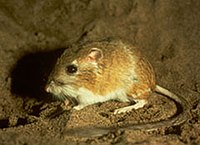
Weak interspecific interactions in a sagebrush steppe? Conflicting evidence from observations and experiments.
Sign Up to like & getrecommendations! Published in 2018 at "Ecology"
DOI: 10.1002/ecy.2363
Abstract: Stable coexistence requires intraspecific limitations to be stronger than interspecific limitations. The greater the difference between intra- and interspecific limitations, the more stable the coexistence, and the weaker the competitive release any species should experience… read more here.
Keywords: interspecific interactions; removal; weak interspecific; sagebrush steppe ... See more keywords

Simulating cheatgrass (Bromus tectorum) invasion decreases access to food resources for small mammals in sagebrush steppe
Sign Up to like & getrecommendations! Published in 2018 at "Biological Invasions"
DOI: 10.1007/s10530-018-1701-8
Abstract: Invasions by nonnative plants can alter the abundance of native animals, yet we know little about the mechanisms driving these changes. Shifts in vegetation characteristics resulting from nonnative plants can alter availability of food resources,… read more here.
Keywords: invasion; sagebrush steppe; cheatgrass; small mammals ... See more keywords

Effectiveness of prescribed fire to re-establish sagebrush steppe vegetation and ecohydrologic function on woodland-encroached sagebrush rangelands, Great Basin, USA: Part II: Runoff and sediment transport at the patch scale
Sign Up to like & getrecommendations! Published in 2020 at "Catena"
DOI: 10.1016/j.catena.2019.104301
Abstract: Abstract Woody species encroachment into herbaceous and shrub-dominated vegetations is a concern in many rangeland ecosystems of the world. Arrival of woody species into affected rangelands leads to changes in the spatial structure of vegetation… read more here.
Keywords: prescribed fire; runoff erosion; erosion; sagebrush steppe ... See more keywords

Effects of conifer treatments on soil nutrient availability and plant composition in sagebrush steppe
Sign Up to like & getrecommendations! Published in 2017 at "Forest Ecology and Management"
DOI: 10.1016/j.foreco.2017.06.033
Abstract: Abstract Pinon-juniper woodlands of the western United States have expanded 2 to 10-fold since the late 1800’s. Tree control measures using chainsaws, heavy equipment and prescribed fire have been used to reduce woodlands and restore… read more here.
Keywords: availability; nutrient availability; sagebrush; sagebrush steppe ... See more keywords

Spatiotemporal dynamics of insect pollinator communities in sagebrush steppe associated with weather and vegetation
Sign Up to like & getrecommendations! Published in 2021 at "Global Ecology and Conservation"
DOI: 10.1016/j.gecco.2021.e01691
Abstract: Abstract The conservation of native insect pollinators is hampered by a lack of information about environmental factors influencing pollinator communities. We investigated how insect pollinator communities, composed of bees (Hymenoptera), butterflies and moths (Lepidoptera), and… read more here.
Keywords: dynamics insect; pollinator communities; insect pollinator; spatiotemporal dynamics ... See more keywords

Impacts of Feral Horse Use on Herbaceous Riparian Vegetation within a Sagebrush Steppe Ecosystem
Sign Up to like & getrecommendations! Published in 2017 at "Rangeland Ecology and Management"
DOI: 10.1016/j.rama.2017.02.001
Abstract: ABSTRACT Feral horses inhabit rangeland ecosystems around the world, and their impacts on riparian ecosystems are poorly understood. We characterized impacts of a free-ranging horse population on the structure and composition of riparian plant communities… read more here.
Keywords: horse; plant; grazed plots; sagebrush steppe ... See more keywords

Longer-term post-fire succession on Wyoming big sagebrush steppe
Sign Up to like & getrecommendations! Published in 2020 at "International Journal of Wildland Fire"
DOI: 10.1071/wf19109
Abstract: We assessed plant community succession following prescribed fire on ungrazed Wyoming big sagebrush steppe, eastern Oregon. Treatments were burned (Burn; September and October, 2002) and unburned (Control) sagebrush steppe. Herbaceous yield, vegetation canopy cover and… read more here.
Keywords: fire; wyoming big; big sagebrush; sagebrush steppe ... See more keywords

Seedling defoliation may enhance survival of dominant wheatgrasses but not Poa secunda seeded for restoration in the sagebrush steppe of the Northern Great Basin.
Sign Up to like & getrecommendations! Published in 2021 at "AoB PLANTS"
DOI: 10.1093/aobpla/plab047
Abstract: Restoration of dryland ecosystems is often limited by low seedling establishment and survival. Defoliation caused by insects and small mammals could be an overlooked cause of seedling mortality. In the sagebrush steppe, we examined the… read more here.
Keywords: defoliation; sagebrush steppe; restoration; seedling defoliation ... See more keywords

Soil microbial communities and elk foraging intensity: implications for soil biogeochemical cycling in the sagebrush steppe.
Sign Up to like & getrecommendations! Published in 2017 at "Ecology letters"
DOI: 10.1111/ele.12722
Abstract: Foraging intensity of large herbivores may exert an indirect top-down ecological force on soil microbial communities via changes in plant litter inputs. We investigated the responses of the soil microbial community to elk (Cervus elaphus)… read more here.
Keywords: soil microbial; sagebrush steppe; intensity; foraging intensity ... See more keywords